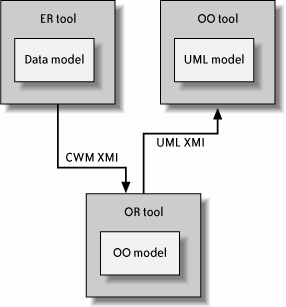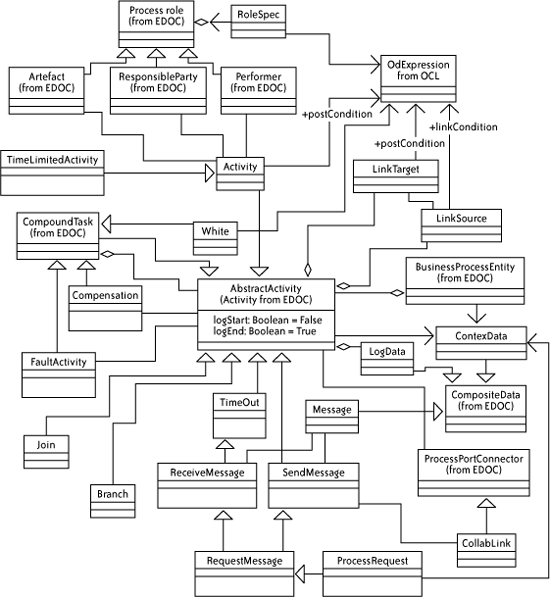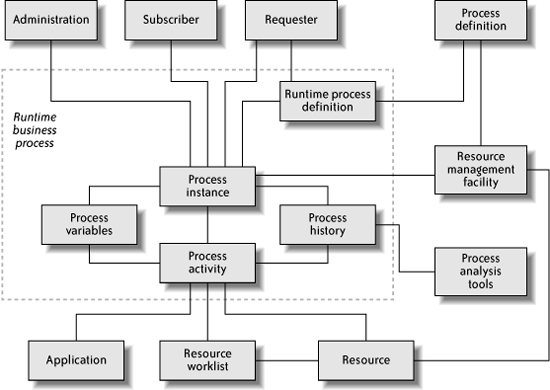Section 9.1. OMG: Model-Driven BPM
9.1. OMG: Model-Driven BPMEstablished in 1989, the Object Management Group (OMG, http://www.omg.org), is a consortium of more than 500 companies, and is best known for its standards-based work on the Common Object Request Broker Architecture (CORBA), UML, and MDA. Though CORBA's popularity has been declining ever since its boom in the mid-1990s, UML continues to thrive after more than a decade, and the newborn MDA is enjoying burgeoning press coverage and vendor interest. The OMG recently has taken an interest in BPM, publishing Requests for Proposals (RFPs) for the specification of abstract models for business process diagrams and business process runtime interfaces.[*] The RFP processto be managed by the OMG's Business Enterprise Integration Domain Task Force (BEIDTF) , headed by EDS and Hendryx Associatesis in its early stages, but its intriguing feature is not the competition of bids, but the type of solution being sought. The OMG wants an MDA for BPMa mutually beneficial arrangement, because not only is BPM a compelling example of an MDA, MDA promises to be a boon to BPM.
Members of the OMG include AT&T, BEA, Borland, Boeing, CA, Citigroup, Compaq, Compuware, Ericsson, Ford, Fujitsu, Glaxo Smith Kline, HP, Hitachi, Hyperion, IBM, IONA, Microsoft, NASA, NEC, Oracle, Pfizer, Rational, SAP, SAS, Siemens, Sprint, Sun, and Unisys. 9.1.1. Model-Driven ArchitectureMDA is, in a sense, a means of unifying disparate approaches to a given software problem. Software has seemingly countless types of models: relational data models, object-oriented models, business process models, and others. MDA accepts the diversity but provides a mechanism to map one model to another. The key idea is to base all models on a common foundation. Two approaches are recommended:
Another key feature is the ability to move models between MDA-based tools. XML Metadata Interchange (XMI) enables a MOF-based model to be represented as an XML document, structured according to an XML schema specific to the type of model. In Figure 9-1, for example, an object-relational (OR) mapping tool can be built to accept, from an entity-relationship (ER) tool , relational data models as CWM XMI documents. The OR tool can then generate an object-oriented representation of the data model and output it as a UML XMI document, which can then be fed into an object-oriented (OO) tool . Figure 9-1. XMI for OR mapping 9.1.2. BPM and MDAThe OMG's primary interest in BPM is in two areas: process definitions and runtime interfaces. The OMG has published RFPs seeking MDA models for the BPDM[*] and BPRI[
9.1.2.1 BPDMThe commonality of process definition languages is remarkable. BPEL, BPML, BPMN, XPDL, XLANG, WSFL, and UML activity diagrams are variations on a theme. The RFP for BPDM seeks the authoritative MOF metamodel, or UML profile, for a process definition that isolates what is common and elemental. The model that is eventually ratified by the OMG will sit alongside UML and CWM in the MOF hierarchy and will be interchangeable with them through XMI. In addition, the model makes it easier to map between existing process languages. In Figure 9-2, a BPEL tool exchanges processes with a BPMN tool as BPDM XMI documents. Each tool can both export and import its processes as BPDM XMI, and can also import UML XMI originating from a UML modeling tool. (See the later sidebar "UML To BPEL: IBM's Emerging Technologies Toolkit" for more on the UML dimension.) Figure 9-2. Tools exchange process models, thanks to MDA The requirements for BPDM are obvious: a notion of process, activity, and choreography; support for basic patterns such as AND, OR, and loops; role assignment and access control; auditing ; and event publication and subscription. An initial submission prepared by EDS, Data Access Technologies, Borland, and 88 Solutions[*] posits a model, shown in Figure 9-3, based on Enterprise Distributed Object Computing (EDOC) , an emerging process-oriented application framework. The particulars are too immature to warrant discussion in the book at this time. What is significant is the attempt to devise a unified theory of process definition.
Figure 9-3. BPDM model from EDS response to OMG RFP NOTE The OMG is collaborating with BPMI (the group that owns the BPML and BPMN specifications) on BPDM. The BPMI is building a BPDM metamodel known as Business Process Semantic Model (BPSM). The OMG is also pursuing the BPEL group of OASIS; BPEL support is considered essential for BPDM. 9.1.2.2 BPRIBPRI is an interface describing instances of processes and their activities, including current state, current variable values, and history. Like the WfMC's WAPI interface (examined in Chapter 7), BPRI offers administration and monitoring services, as well as human and application participant coordination. The main entities and their relationships are depicted in Figure 9-4. Figure 9-4. OMG BPRI model from OMG BPRI RFP At the center of the diagram, surrounded by a dotted box, are the primary runtime elements, including process instance, its activities and variables, and its historical information store, which special process analysis tools tap into for reporting purposes. An instance, which instantiates a process definition, is initiated by a requester, is administered (e.g., get and set state, find active instances) by an administrator, and is monitored (e.g., tracking when an instance terminates) by a subscriber. Activities are generally performed either by human beings (Resource) or systems (Application). Activities assigned to human beings are organized into worklists, and human beings are grouped into work roles through the resource management facility. The OMG recommends a runtime model similar to Example 9-5. The model should be platform-independent, from which platform-specific models based on CORBA or J2EE, for instance, can be derived. As with BPDM, the possibility of a unified theory for a BPM API is intriguing. Standardization in this area is far less active than with process definition; with the exception of WAPI, most APIs are proprietary vendor interfaces. 9.1.2.3 UML to BPEL: IBM's emerging technologies toolkitIBM, an ardent supporter of UML, BPEL, and MDA, has built a tool to generate BPEL code from UML diagrams. The tool, known as the Emerging Technologies Toolkit (ETTK) ,[*] is a plug-in to the open-source Java development studio Eclipse. The plug-in inputs a file in the form of UML XMI and outputs WSDL and BPEL files. The UML model can be created in IBM's Rational Rose or Rational XDE products, each of which supports the design of UML models and their export to XMI.
The ETTK requires that the UML model have the following diagrams:
The end-to-end view is shown in Figure 9-5. Figure 9-5. IBM ETTK generates BPEL from UML 9.1.2.4 Other OMG BPM RFPsNewer and probably less crucial are the OMG-solicited models described in Table 9-1. These are works in progress.
|
EAN: 2147483647
Pages: 122
 ] standards.
] standards.